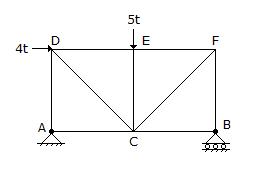Discussion
Home ‣ Civil Engineering ‣ Highway Engineering See What Others Are Saying!
- Question
Camber in pavements is provided by
Options- A. straight line method
- B. parabola method
- C. straight at the edges and parabolic at the crown
- D. all the above.
- Correct Answer
- all the above.
- 1. Acid regression stage of sludge digestion at a temperature 21°C extends over a period of
Options- A. 15 days
- B. 30 days
- C. 60 days
- D. 90 days. Discuss
- 2. If the width of the foundation for two equal columns is restricted, the shape of the footing generally adopted, is
Options- A. square
- B. rectangular
- C. trapezoidal
- D. triangular. Discuss
- 3. At eastern elongation, the pole star moves
Options- A. eastward
- B. westward
- C. northward
- D. southward. Discuss
- 4. For loss of head in a canal inverted syphon barrel, the factor in the Unwin formula
 is a coefficient for loss of head due to
is a coefficient for loss of head due to
Options- A. friction
- B. exit
- C. entry
- D. gradient Discuss
- 5. The force in AD of the truss shown in given figure, is

Options- A. 4.0t compression
- B. 3.0t compression
- C. 0.5t compression
- D. 0.5t tension
- E. zero. Discuss
- 6. Rapid curing cut back bitumen is produced by blending bitumen with
Options- A. Kerosene
- B. Benzene
- C. Diesel
- D. Petrol Discuss
- 7. Fresh sewage is generally
Options- A. alkaline
- B. acidic
- C. highly decomposed
- D. a source of objectionable odour. Discuss
- 8. The coefficient ka of the active earth pressure, is given by
Options- A.

- B.

- C.

- D.
 Discuss
Discuss
- 9. Pick up the correct statement from the following:
Options- A. The diameter of a rivet, before driving is taken as the nominal diameter of the rivet
- B. The diameter of the rivet hole is taken as the gross area of the rivet
- C. For rivets of nominal diameters less than 25 mm, the diameter of the rivet hole is taken as the nominal diameter of the rivet plus 1.5 mm
- D. For rivets of nominal diameters exceeding 25 mm, the diameter of the rivet hole is taken as the nominal diameter of the rivet plus 2 mm
- E. All the above. Discuss
- 10. Ratio of bearing capacity of double Under Reamed (U.R.) pile to that of single U.R. pile is nearly
Options- A. 2
- B. 1.5
- C. 1.2
- D. 1.7 Discuss
More questions
Correct Answer: 90 days.
Correct Answer: rectangular
Correct Answer: northward
Correct Answer: entry
Correct Answer: 0.5t compression
Correct Answer: Petrol
Correct Answer: alkaline
Correct Answer:

Correct Answer: All the above.
Correct Answer: 1.5
Comments
There are no comments.More in Civil Engineering:
Advanced SurveyingAirport EngineeringApplied MechanicsBuilding ConstructionBuilding MaterialsConcrete TechnologyConstruction ManagementDocks and HarboursElements of Remote SensingEngineering EconomyEstimating and CostingGATE Exam QuestionsHighway EngineeringHydraulicsIrrigationRailwaysRCC Structures DesignSI UnitsSoil Mechanics and Foundation EngineeringSteel Structure DesignStrength of MaterialsStructural Design SpecificationsSurveyingTheory of StructuresTunnellingUPSC Civil Service Exam QuestionsWaste Water EngineeringWater Resources EngineeringWater Supply EngineeringProgramming
Copyright ©CuriousTab. All rights reserved.
